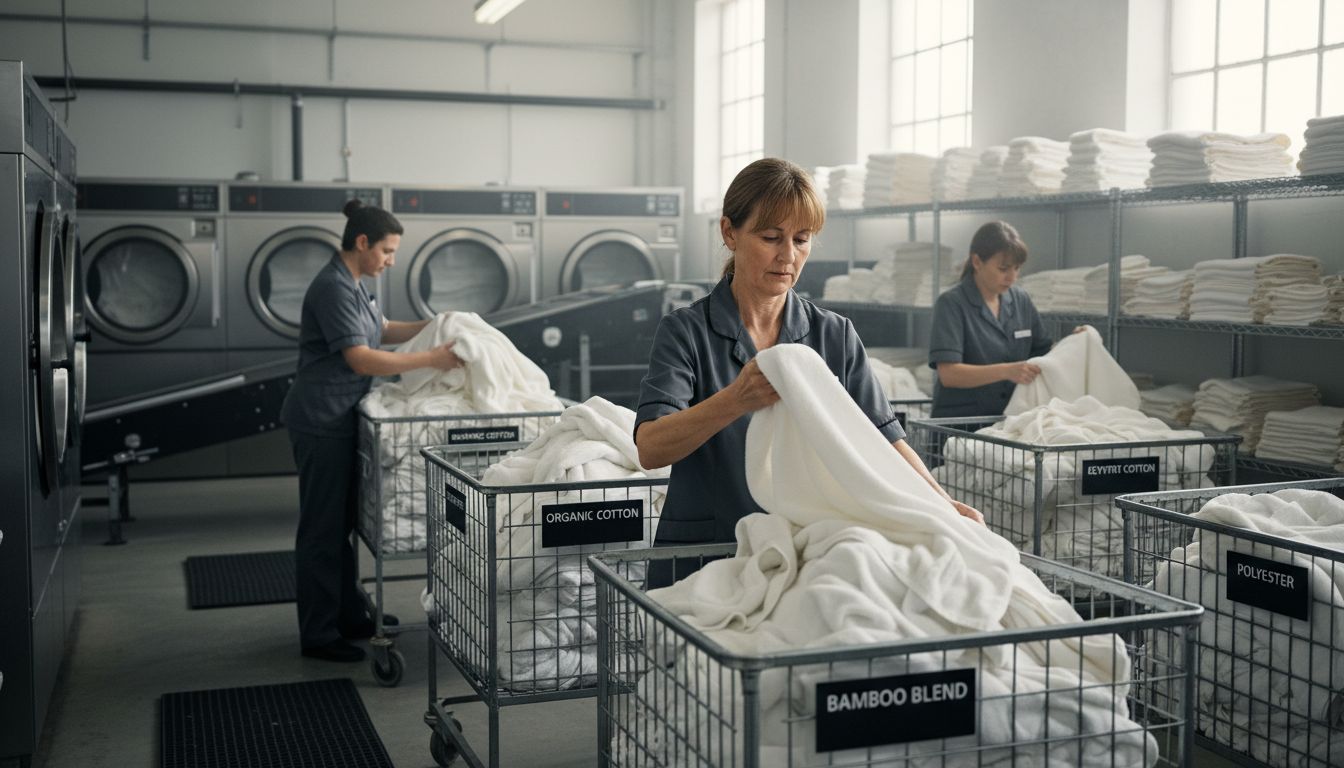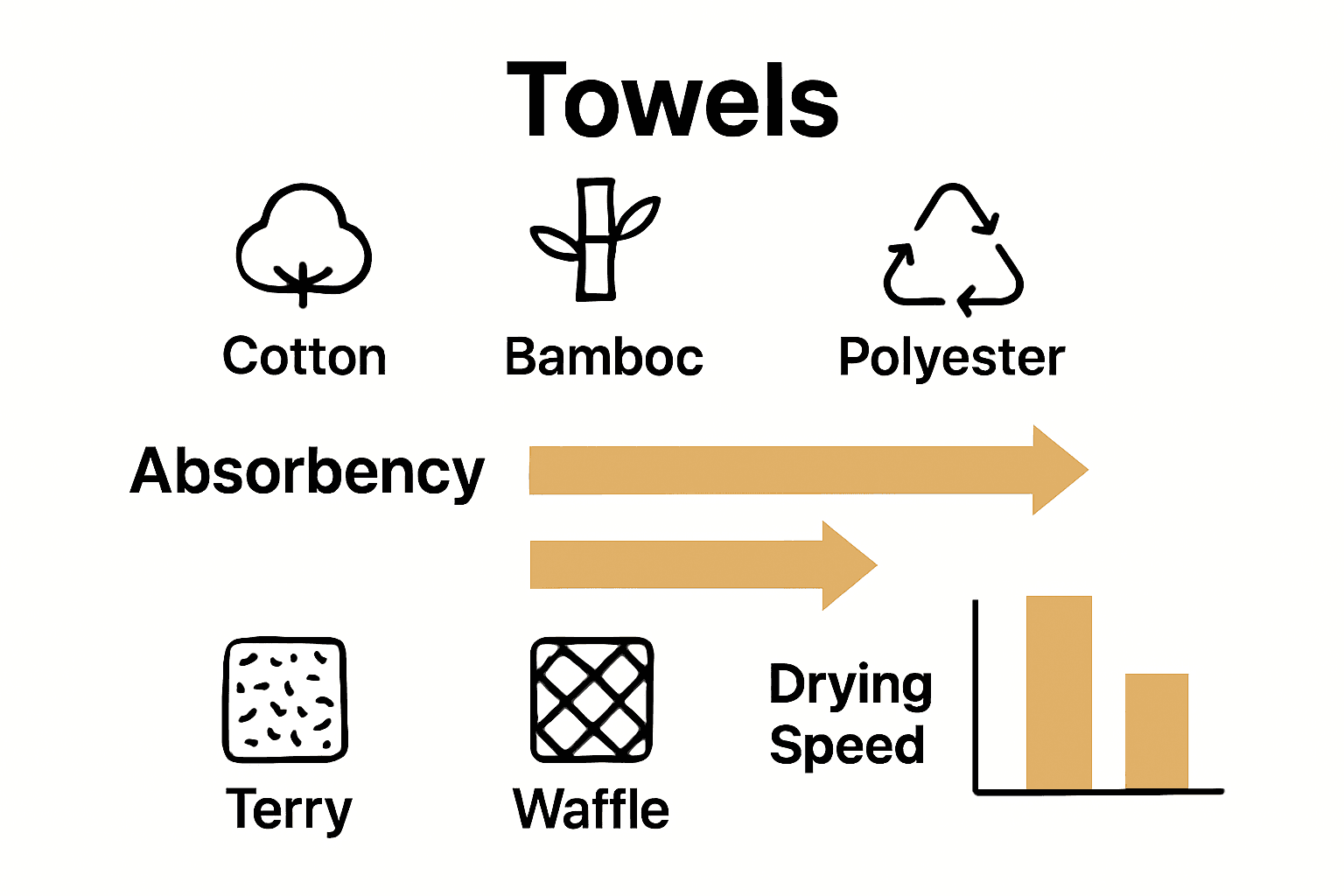Most american households believe the fluffiest towels are always the most absorbent, but that is not always true. The real science behind towel absorbency involves fiber structure, weave, and careful manufacturing choices, not just thickness or brand. Misunderstandings about towel performance linger, and over 60 percent of people use fabric softener in ways that harm absorbency. This article clarifies common myths and spotlights what really makes a towel effective at drying you off.
Table of Contents
- Defining Absorbency In Towels And Common Myths
- How Materials Impact Towel Absorbency
- Towel Weaves And Their Absorbent Qualities
- Manufacturing Processes That Influence Absorbency
- Care Practices For Maximizing Towel Performance
Key Takeaways
| Point | Details |
|---|---|
| Towel Absorbency Factors | Absorbency is determined by fiber type, weave structure, and manufacturing techniques, not just softness. Cotton, especially Egyptian cotton, is preferred for its hydrophilic properties. |
| Impact of Fabric Softeners | Use fabric softeners sparingly as they can coat fibers, reducing absorbency. A better alternative is white vinegar for residue removal. |
| Material Importance | Organic cotton and bamboo are excellent for absorbency, while synthetic materials like polyester are less effective. Selecting blends can enhance performance. |
| Weave Designs | Terry weaves excel in moisture absorption, whereas waffle weaves are beneficial for quick drying. Choose based on your drying needs and environmental conditions. |
Defining Absorbency In Towels and Common Myths
Absorbency in towels isn’t just about how wet a fabric feels - it’s a complex interplay of material science, fiber structure, and manufacturing techniques that determines how effectively a towel can pull moisture from your skin. Understanding towel absorbency means looking beyond surface-level assumptions and diving into the microscopic world of textile engineering.
At its core, towel absorbency depends on the textile’s ability to rapidly draw moisture into its fibers and spread that liquid across its surface. Cotton remains the gold standard for absorption because of its natural hydrophilic properties - meaning water molecules are attracted to and quickly integrated into its fiber structure. When examining towel performance, experts look at factors like fiber length, weave density, and surface texture.
Contrary to popular belief, not all soft towels are equally absorbent. According to Ideal Home, laundry experts warn that fabric softeners can dramatically reduce a towel’s absorbency. These products coat towel fibers with a waxy layer that clogs the cotton loops essential for water absorption. Cleaning Hacks recommends using fabric softener sparingly - no more than once every three washes - to maintain both fluffiness and absorption capabilities.
Common myths about towel absorbency often revolve around thickness, brand, or price point. In reality, absorption is more about fiber quality, weave technique, and proper maintenance. A thin, well-constructed Turkish cotton towel can outperform a thick, poorly manufactured terry cloth towel. The key is understanding that absorbency isn’t about how plush a towel feels, but how effectively it can wick moisture away from your skin quickly and efficiently. Learn more about choosing the perfect towels in our guide on bath towel selection.
How Materials Impact Towel Absorbency
Towel materials play a critical role in determining overall absorption performance, with each fabric type offering unique moisture-wicking characteristics that impact your drying experience. The right material can transform a simple towel from a basic bathroom accessory into a highly functional textile engineered for maximum comfort and efficiency.
According to Eco Linen, organic cotton stands out as a superior material due to its longer, smoother fibers that create softer and more absorbent towels. Natural fibers like cotton and linen excel at moisture absorption, while synthetic materials like polyester struggle to effectively draw water away from the skin. The Mad Top further confirms that cotton remains the gold standard, particularly Egyptian cotton with its extra-long staple fibers that produce ultra-soft and highly absorbent towels.
Different materials offer unique advantages for towel performance. Cotton provides exceptional moisture absorption and softness, while bamboo blends emerge as an eco-friendly alternative with natural absorbent properties. Linen towels, though lighter and crisper, offer quick-drying capabilities and remarkable durability. The key is understanding that material composition directly influences a towel’s ability to efficiently wick moisture, maintain softness, and provide a comfortable drying experience.
When selecting towels, consider not just the primary material but also potential blends that enhance performance. Explore our comprehensive guide to the best absorbing towel materials to make an informed decision that balances comfort, absorption, and sustainability. A thoughtful selection goes beyond aesthetic preferences, focusing on the scientific properties that make a truly exceptional towel.

Towel Weaves and Their Absorbent Qualities
Towel weaves are the architectural blueprint of textile performance, determining how effectively a towel can absorb and distribute moisture across its surface. Understanding the intricate relationship between weave structure and water absorption transforms how we select and appreciate these everyday essentials.
According to Eco Linen, the terry weave represents the pinnacle of absorbent design. This specialized weave maximizes surface area by creating numerous exposed loops that dramatically increase a towel’s moisture-capturing capabilities. The strategic positioning of these loops allows the fabric to trap and quickly absorb water, making terry cloth the gold standard for bath and beach towels that need maximum water retention.
Not all weaves are created equal in their moisture management. While terry weaves excel in absorption, waffle weave towels offer a compelling alternative for those prioritizing quick drying and breathability. These lighter towels are particularly advantageous in humid climates, where rapid moisture evaporation prevents that dreaded damp, musty feeling. The geometric pattern of waffle weaves creates small pockets that enhance air circulation, allowing the towel to dry faster while still maintaining respectable absorption properties.
Learn more about the fascinating world of towel textiles in our guide to terry cloth, where we break down the nuanced engineering behind these seemingly simple fabrics. Choosing the right weave isn’t just about aesthetics - it’s about selecting a textile that matches your specific environmental needs, personal comfort preferences, and performance expectations.
Manufacturing Processes That Influence Absorbency
Textile manufacturing is a complex science where seemingly minor production choices can dramatically transform a towel’s performance and moisture-management capabilities. The journey from raw fiber to finished product involves intricate decisions that directly impact how effectively a towel can absorb and retain water.
Research from AJER reveals that towel absorbency is fundamentally influenced by surface area manipulation and yarn engineering. Manufacturers can increase absorption by strategically creating pile yarns and utilizing microfiber technologies. Microfiber yarns offer a unique advantage, providing higher bursting strength due to their dense fiber cross-section, which translates to enhanced water-trapping capabilities and improved overall towel performance.
According to European Scientific Journal, the twist of cotton yarns plays a critical role in absorbency. Lower twist levels in pile yarns create more space between fibers, allowing for greater moisture absorption. The natural convoluted structure of cotton fibers further enhances this process, trapping air and creating additional surface area for water retention. This means that the seemingly simple act of adjusting yarn twist can significantly impact a towel’s ability to quickly and effectively dry your skin.
Explore the nuanced world of terry cloth manufacturing in our comprehensive guide, where we delve into the intricate processes that transform ordinary fabric into extraordinary towels. Understanding these manufacturing subtleties empowers consumers to make informed choices, recognizing that true textile excellence lies in the details of production.
Care Practices for Maximizing Towel Performance
Towel maintenance is an art form that extends far beyond simple washing - it’s about preserving the intricate textile engineering that makes your towels soft, absorbent, and long-lasting. The way you clean, dry, and store your towels can dramatically impact their performance and lifespan.
According to Ideal Home, a surprising secret to towel restoration involves white vinegar. By washing your towels with one cup of white vinegar every six weeks, you can effectively remove detergent and softener residue that gradually diminishes absorbency. Wool dryer balls offer another innovative solution, naturally softening towels while reducing drying times and maintaining the fabric’s moisture-wicking capabilities.
Eco Linen emphasizes the critical importance of washing technique. Warm water and gentle detergent help maintain the open loops essential for effective water absorption. Avoid fabric softeners at all costs - these products create a waxy coating that blocks the very fibers responsible for drawing moisture away from your skin. Pre-washing and gentle treatment can actually improve towel performance by opening up fibers and removing manufacturing residues that might impede absorption.
Explore our quick-dry towel collection for performance-engineered fabrics that make maintenance easier and more effective. Remember, towel care is an investment in comfort - treat your textiles with intention, and they’ll reward you with years of exceptional performance.
Discover Towels That Truly Deliver on Absorbency and Comfort
Choosing towels that combine premium materials with expert textile engineering can solve the frustration of towels that feel soft but fail to absorb. The article highlights how fabric choice, weave structures like terry loops, and proper yarn manufacturing all influence absorbency. It also stresses how everyday care impacts towel performance and durability. If you want to experience towels that wick moisture quickly without sacrificing plushness explore options designed with these scientific insights in mind.

Shop at Lotus Linen to find towels crafted from high-quality cotton and luxurious waffle weaves engineered for maximum moisture absorption and quick drying. Our collection blends elegant aesthetics with effective textile science so you can enjoy indulgent comfort that lasts. Visit our bath towel selection guide for helpful tips on how to pick towels tailored to your needs. Start elevating your drying experience today with towels built to perform at every touch.
Frequently Asked Questions
What factors determine towel absorbency?
Towel absorbency is influenced by the material, fiber quality, weave structure, and manufacturing techniques. Cotton, particularly Egyptian cotton with its long fibers, is known for excellent absorption due to its natural hydrophilic properties.
Can fabric softeners affect the absorbency of towels?
Yes, fabric softeners can significantly reduce a towel’s absorbency by coating the fibers, which clogs the loops essential for effective moisture absorption. It’s advised to use fabric softeners sparingly to maintain absorbency.
How does the weave type impact a towel’s ability to absorb water?
The weave type, such as terry or waffle, plays a crucial role in a towel’s absorbency. Terry cloth has loops that increase surface area for moisture capture, while waffle weave towels prioritize quick drying and breathability, making them suitable for different needs.
What are the best care practices to maintain towel absorbency?
To maximize towel performance, wash them with warm water and gentle detergent, avoid fabric softeners, and occasionally use white vinegar to remove detergent residues. Allowing towels to dry thoroughly after use also helps maintain their absorbent qualities.

Recommended
- How to Choose Bath Towels: Selecting the Perfect Luxe Towels – Lotus Linen
- What Is Terry Cloth? Guide to Cozy, Stylish Choices 2025 – Lotus Linen
- Choosing Robes for Guests: Create Comfort and Style – Lotus Linen
- Best Absorbing Towel Materials for 2025: Guide for Luxury & Comfort – Lotus Linen
- How to Store Linens: Easy Tips for an Organized Home (2025) – BLUSHBEES USA
